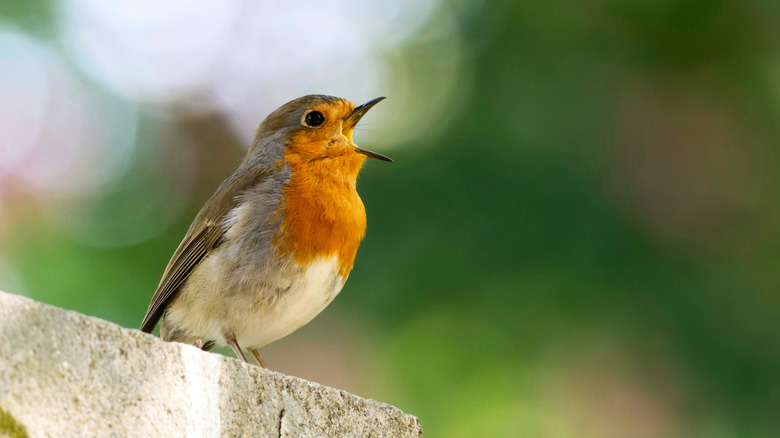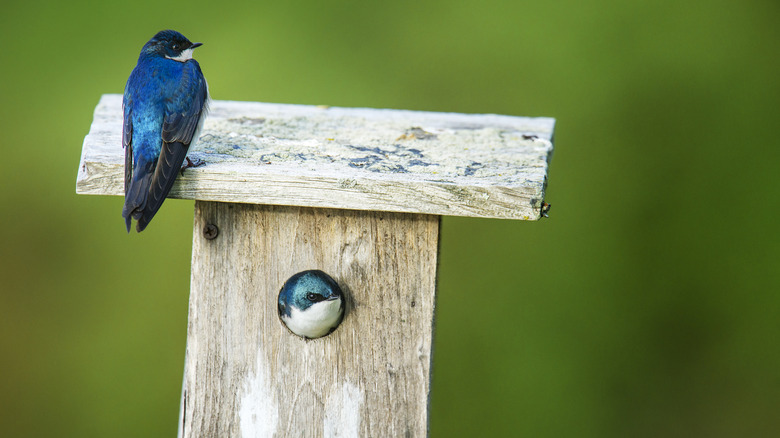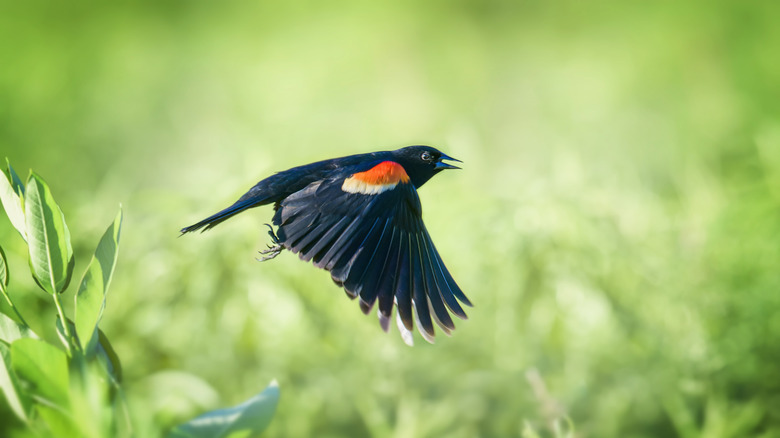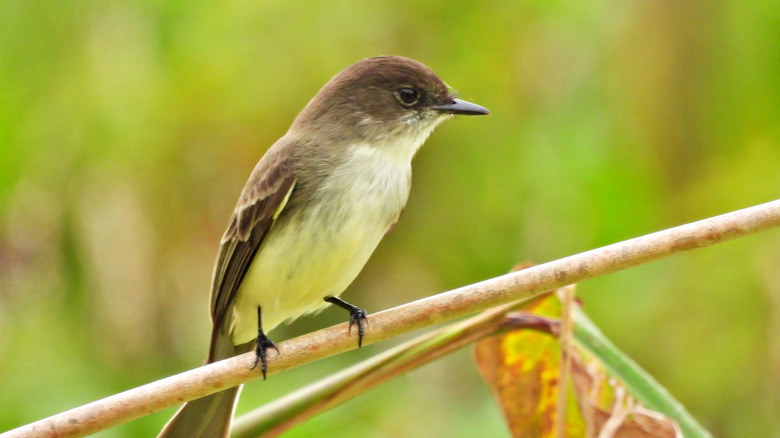The First Birds You'll See In Your Yard This Spring
As the dreary days of winter begin to fade away and we move into spring, you'll likely hear the sounds of singing birds in the trees — a sure sign of the season's arrival. Spring makes its appearance at different times across the United States, varying by climate, and American robins generally symbolize this seasonal transition. However, regardless of your location, the other birds you commonly see first as winter fades away are tree swallows, red-winged blackbirds, and, for Eastern residents, the Eastern phoebe. These birds are among the earliest migrators, though the American robin can also be a year-round resident in some areas, remaining quiet when it's colder.
Beyond being a welcome sight for sore eyes weary of winter, spring's birds can offer valuable benefits to your area. Several early spring birds are insectivores that eradicate troublesome pests that would otherwise plague your yard or garden. As important parts of the ecosystem, they help keep the insect population in check, some capable of eating one insect per minute.
Outside of the birds' beneficial pest control services, seeing their colorful plumage and hearing their cheerful song offer something else: a feeling of hope and renewal, much like spring itself. Their presence is a pleasant reminder that blooms will appear, and soon, our surroundings will burst with color and new life once again. Whether you're an avid birdwatcher or are simply excited to welcome some new feathered visitors to your home, here's a deeper look at the birds you should expect first thing in spring.
American Robins return to the area or reappear after hiding
The American robin is known as the harbinger of spring and is often spotted at the season's start. However, depending on your area, these birds may be year-round residents and not migrate unless faced with a dwindling food supply. In colder spots, such as northern Canada, robins migrate south largely searching for food, not to escape from the cold. They often come into the United States, sometimes traveling as far as Mexico. In the winter, they tend to flock together, becoming nomadic as they search for sustenance. Even in the areas where they stay year-round, it's their first cheery songs that make us feel as if they've returned after a winter away, like other migratory birds. In reality, however, they may have simply moved to forested areas rather than staying in the open as they enjoy doing in the spring.
Robins feature gray and brown feathers with darker plumage on their heads and a deep orange breast. You can tell the sexes apart because females, while sharing similar coloring, have paler feathers on their heads. Both sexes sport white-patched bellies and under tails, though you may occasionally see a robin with white spots throughout its back — these birds have leucism, a condition affecting the feathers' pigment. You can attract robins to your garden by meeting them at their level, literally, using a tray on the ground filled with crushed peanuts and seeds. Apple slices, berries, and raisins are also a winner with robins, as are dried mealworms.
Tree swallows are dazzling spring arrivals
With beautiful back feathers of a brilliant blue, tree swallows are a welcome sight after winter's gloom as they swoop through the air, catching their favorite prey: insects. Their plumage is iridescent, shifting from blue to blue-green in a certain light. However, their chest and belly are white. The males are more brightly colored, while females feature more brown in their upper body.
Classified as short-to-medium distance migrators, tree swallows typically migrate in the summer months, from July through September. During this time, flocks can number hundreds of thousands of birds, swirling in dramatic formations in the air as they head to the southern United States, Mexico, and sometimes as far south as Central America. Tree swallows then return home for spring, earlier than other swallows. Thanks to their varied diet of insects and plants, they survive the colder temperatures of early spring. March and April see them venture back to their breeding grounds in the northern U.S. and Canada.
Tree swallows are the types of birds you want in your yard because they contribute to pest control. Since they have an insect-heavy diet, they won't be interested in seeds like other songbirds. However, as they're cavity-nesting birds, you can draw them onto your property to breed using a nest box. Another way to attract tree swallows is by adding a water feature to increase their foraging opportunities for creepy crawlies.
Red-winged blackbirds' song permeates the sky from up on high
As their name suggests, red-winged blackbirds are nearly all black with red and yellow plumage on their wings. The males are more striking, bearing a glossy, dark black plumage, with dark brown streaks throughout their bodies. Females feature yellow coloring underneath their bill with an occasional white eyebrow, while the males' bills are solid black. Like American robins, red-winged blackbirds can reside all year long in an area, often around marshes or near ponds. The northern population may venture south to warmer areas such as Mexico, while those residing in warmer regions typically stay in place. The migrating birds make a dramatic appearance in the spring, when males return first or reappear on elevated perches, loudly defending their territory with a piercing song. They're very territorial, with males having multiple partners, even breeding with more than 10 females during mating season.
As ground feeders, red-winged blackbirds will eat bird seed and grains scattered on the ground. Sprinkle crushed peanuts, sunflower hearts, oats, and cracked corn for them, and you may see them swoop down from the telephone wires or a fence post to graze. As they eat, they may enjoy a few of their other favorite foods — insects, including beetles and grasshoppers, and spiders. Feeding red-winged blackbirds with a suet feeder is also a good way to attract them but do be aware they can be aggressive. They're considered bully birds, sometimes chasing away other birds from a feeder, though only briefly.
Eastern phoebes are a welcome spring sight in the east
In the Eastern United States, the Eastern phoebe signifies approaching spring despite lacking the striking colors of the American robin or the tree swallow. Another short-to-medium distance migrant, this bird winters farther north than many other species, returning earlier in the spring. They're easy to spot; just search for the short, gray-colored bird frequently wagging its tail. Plumage is relatively plain, with brown-to-gray feathers, the darkest of which appear at the head, contrasting with a white breast and belly. Their song is similar to their name, as they emit a soft "fee-bee" sound, changing the pitch as they repeat it in succession.
Eastern phoebes are insectivores that dart into the air from their perch to catch prey. They catch flies but happily eat larger insects too. You can encourage them to remove some of the most troublesome insects, such as ticks or wasps, by providing a perch where they may sit and wait to make their move. The Eastern phoebe can be an impressive hunter, capable of catching 1.21 insects per minute, according to the National Park Service (NPS). While insects comprise most of their diet, they will eat berries, such as those from the Virginia creeper. Bird baths or ponds can entice these birds, letting them seek out nearby insect activity. Consider also using a nesting box and attaching it to a building's overhang, if possible, from a height of at least 3 to 16 feet.




